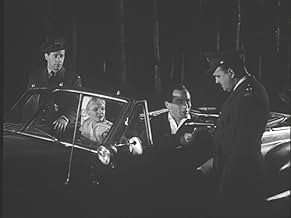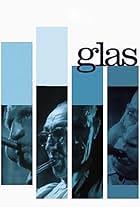The famous statue of Manneken Pis is stolen in Brussels.The famous statue of Manneken Pis is stolen in Brussels.The famous statue of Manneken Pis is stolen in Brussels.
Jaak Germain
- Prosper
- (as Jaques Germain)
- Director
- Writers
- All cast & crew
- Production, box office & more at IMDbPro
Storyline
Did you know
- ConnectionsFeatured in De wereld draait door: Episode #7.138 (2012)
Featured review
It's good to see all (or as much as humanly possible) of an artist's work, but THE M.P. CASE is definitely minor league Haanstra. I was disappointed, compared to his masterworks.
This slight and silly comedy was a followup to his hit debut fictional feature FANFARE, a classic in the humanist tradition. Perhaps for commercial reasons, the next film, which Haanstra produced himself, merely makes fun of the rivalry between Holland and Belgium, undoubtedly spurred by their soccer matches. It probably generated the requisite yocks for local audiences way back then, but left me cold.
Now I was a huge fan at the very same time of a similar but far better movie, Jack Arnold's classic THE MOUSE THAT ROARED. In that very British comedy (helmed by a superb American B-sci-fi director) the conflict between America and the fictional Grand Duchy of Fenwick hit a universal chord, not unlike the great Ealing comedies that preceded it. Growing up in Cleveland, Ohio I recall waiting endlessly in line to buy a ticket when it was in first run, so popular was the movie. But THE M.P. CASE is extremely parochial and for my money never got off the ground.
Simple premise is that a nerdy hero (Albert Mol, who was far better as the imported conductor in FANFARE) decides to impress his girl friend's dad by stealing the beloved "mannequin pis" statue in Brussels. Dad is a Flemish war vet whose job is to guard the statue and give tourists the usual tour of its history and significance. This is the figure of a little boy peeing as if a fountain. Notion that Mol will become a big shot when he safely returns the statue he's stealing in the first place sort of makes sense, but is a less than compelling "caper film" starting point.
He succeeds in grabbing the little guy, and stashes it with his aunt who is a nun, and who would never be suspected (or searched) for harboring the merchandise at her convent. He spreads rumors that visiting Dutch students, in Belgium for a soccer match won by the locals, stole the statue out of spite. Led by his girl friend's dad Ko van Dijk, a group of Belgian vets decide to steal from rural Holland the equally significant statue of Hans Brinker with his finger in the dam. Rest of the film depicts the hijinks and misunderstandings that ensue, with Mol contrivedly (and unconvincingly) ending up in possession of both statues by film's end emerging, only tentatively, as a hero.
Sight gags and slapstick are on display here, but hardly up to the level of Haanstra's role model Jacques Tati, and not up to snuff of the Ealing comedies (particularly those of Alexander Mackendrick) that he admires. Even the musical score, usually a Haanstra strong suit, is often reduced to just Mickey-Mousing the action at times. Ultimately this is a professional effort, but just not worthy of the Haanstra pantheon of classic cinema.
This slight and silly comedy was a followup to his hit debut fictional feature FANFARE, a classic in the humanist tradition. Perhaps for commercial reasons, the next film, which Haanstra produced himself, merely makes fun of the rivalry between Holland and Belgium, undoubtedly spurred by their soccer matches. It probably generated the requisite yocks for local audiences way back then, but left me cold.
Now I was a huge fan at the very same time of a similar but far better movie, Jack Arnold's classic THE MOUSE THAT ROARED. In that very British comedy (helmed by a superb American B-sci-fi director) the conflict between America and the fictional Grand Duchy of Fenwick hit a universal chord, not unlike the great Ealing comedies that preceded it. Growing up in Cleveland, Ohio I recall waiting endlessly in line to buy a ticket when it was in first run, so popular was the movie. But THE M.P. CASE is extremely parochial and for my money never got off the ground.
Simple premise is that a nerdy hero (Albert Mol, who was far better as the imported conductor in FANFARE) decides to impress his girl friend's dad by stealing the beloved "mannequin pis" statue in Brussels. Dad is a Flemish war vet whose job is to guard the statue and give tourists the usual tour of its history and significance. This is the figure of a little boy peeing as if a fountain. Notion that Mol will become a big shot when he safely returns the statue he's stealing in the first place sort of makes sense, but is a less than compelling "caper film" starting point.
He succeeds in grabbing the little guy, and stashes it with his aunt who is a nun, and who would never be suspected (or searched) for harboring the merchandise at her convent. He spreads rumors that visiting Dutch students, in Belgium for a soccer match won by the locals, stole the statue out of spite. Led by his girl friend's dad Ko van Dijk, a group of Belgian vets decide to steal from rural Holland the equally significant statue of Hans Brinker with his finger in the dam. Rest of the film depicts the hijinks and misunderstandings that ensue, with Mol contrivedly (and unconvincingly) ending up in possession of both statues by film's end emerging, only tentatively, as a hero.
Sight gags and slapstick are on display here, but hardly up to the level of Haanstra's role model Jacques Tati, and not up to snuff of the Ealing comedies (particularly those of Alexander Mackendrick) that he admires. Even the musical score, usually a Haanstra strong suit, is often reduced to just Mickey-Mousing the action at times. Ultimately this is a professional effort, but just not worthy of the Haanstra pantheon of classic cinema.
Details
- Release date
- Countries of origin
- Language
- Also known as
- The M.P. Case
- See more company credits at IMDbPro
Box office
- Budget
- NLG 550,000 (estimated)
- Runtime1 hour 32 minutes
- Color
Contribute to this page
Suggest an edit or add missing content



















